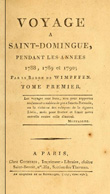Economy
Once the richest colony in the world, Saint Domingue was a leader in the production of sugar, coffee, indigo, cacao, and cotton.
Haiti’s early history is characterized by remarkable economic output. On the eve of the Haitian Revolution, Saint Domingue had become the most lucrative colony on earth. It was the world’s top producer of sugar and coffee and among the global leaders in indigo, cacao and cotton (which was rising rapidly in importance). Indeed, Saint Domingue, occupying only a small territory, outproduced the entire Spanish empire in the Americas. One in eight people in France derived their living from the enormous trade joining France with this small and distant place, 4800 nautical miles away. The reasons for this extraordinary performance can be explained from a number of factors – qualities of land and climate, government support, and more than anything, the presence of a huge number of enslaved Africans who propelled this extensive economic system with their labor. Roughly 8000 plantations (“habitations”) prospered during the eighteenth century, entirely dependent on slavery. To be “as rich as a creole” was a famous boast of the time, and Saint Domingue was lionized as “the pearl of the Antilles.” At its peak, the economy of Saint Domingue created a tax base of one billion livres, and annually sent goods worth 150-170 million livres into France. The books included here offer insight into how this elaborate economy functioned.

